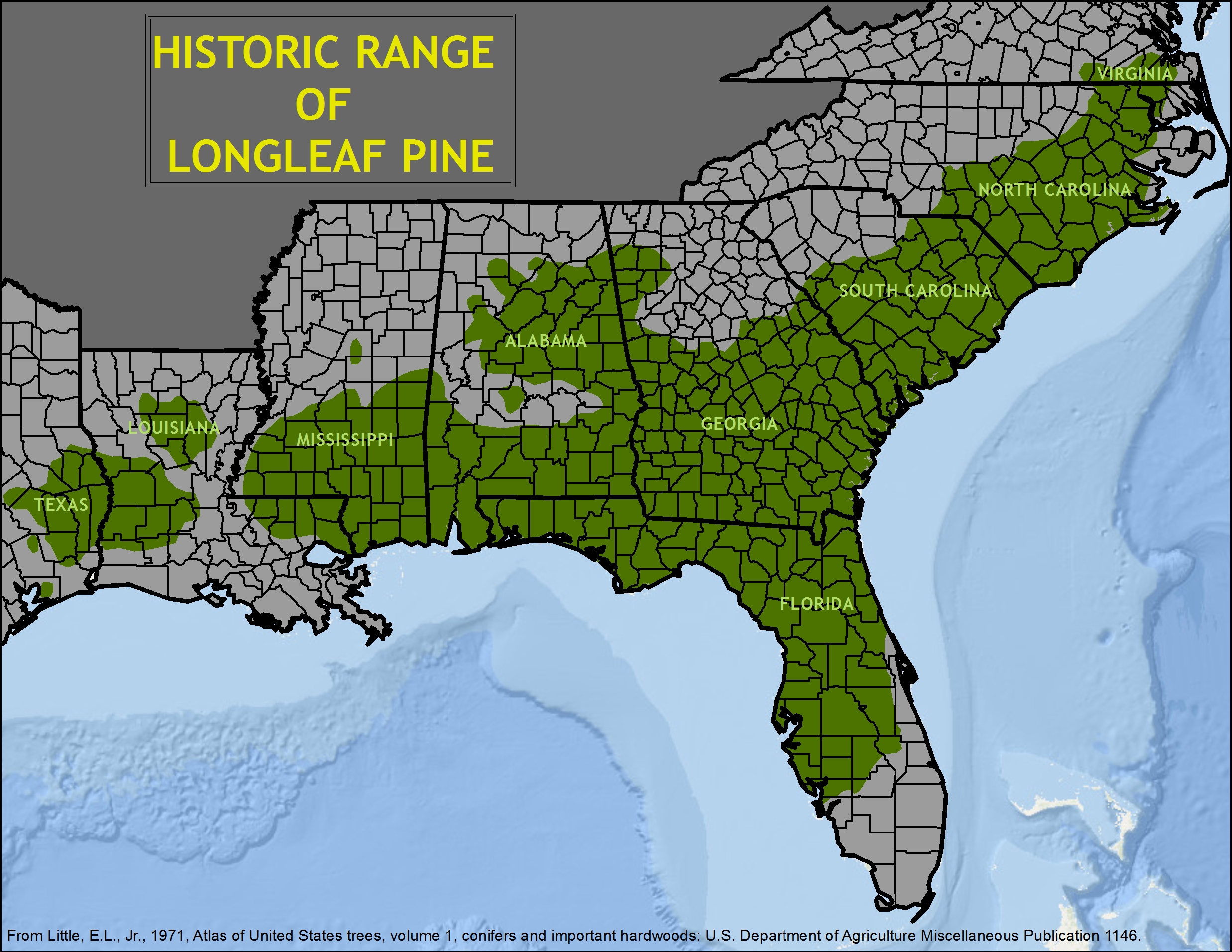
Longleaf Pine Forests
Longleaf pine forests were once one of the most extensive ecosystems in North America. The historic range of longleaf pine stretched from Texas to Virginia, covering approximately 90 million acres. Early explorers described the forest as a vast open park-like savanna of long-needled pine over a diverse understory of grasses and forbs. Frequent fires caused by lightning strikes shaped the longleaf forest for thousands of years, resulting in a unique forest home to many endemic (restricted to a certain area) plants and animals that require fire or habitats created by fire to survive. Longleaf pine is well-suited for the landowner who may want to manage for multiple uses including forest products (timber, pine-straw), recreation, wildlife, and aesthetics. Whether you are a tree farmer, an environmentalist, a hunter, a hiker, or a combination of these, you can enjoy the many superior qualities of a longleaf forest.
Learn more: Introduction to Long Leaf Pine

History, Culture and Tradition
Much of North Carolina’s past was shaped by the longleaf pine. Cattlemen, turpentine producers, loggers and health resorts were born within and thrived under the longleaf pine. Its historic importance is recognized through the State Toast, and the official State Tree of NC is the pine. For many landowners, returning their land to presettlement condition is reason enough to become a part of the longleaf pine restoration effort.
Learn more about the history of longleaf pine in North Carolina.
A Wondrous and Astonishing Diversity
The longleaf forest provides excellent habitat for many wildlife species. The early successional understory layer of legumes and herbs maintained by periodic fire produces lots of hard seed that supports a diverse wildlife population. Quail, turkey, deer and numerous songbirds such as the bachman’s sparrow, pine warbler, and bluebirds, prefer the open, early successional habitat. Many wildlife species prefer the longleaf pine ecosystem and several are found nowhere else. Among them is the southeastern fox squirrel, the largest squirrel in the Southeast, the gopher tortoise in the Gulf Coast region, the northern pine snake, and the red-cockaded woodpecker, the only woodpecker in the world to excavate its cavity in living trees. The wet savannas and flatwoods contain up to 40 different plant species per square meter including many rare plants, such as the roughleaf loosestrife and the unique insectivorous plants such as Venus’s fly-trap and pitcher plants. Of the estimated 1630 plants found in the Southeast, more than half of them are found only in the longleaf ecosystem. This astonishing biodiversity is second only to a tropical rainforest.
Learn more about managing longleaf for wildlife and threatened and endangered species.
Superior Wood Products
Longleaf pine naturally grows straighter, tapers less, and produces a stronger, heavier wood than loblolly pine. Longleaf yields a higher number of poles and pilings whose value is 30-to-40 percent higher than sawtimber. Longleaf pine is commonly grown at harvest rotations of 60-to-80 years, but can grow past 150 years. This long life span allows landowners more time to plan thinning and wait for high timber prices. Longleaf pines respond well to release with increased growth at older ages and higher stand densities. Longleaf pine grows well on less fertile soils and can out compete loblolly pine on poor and average sites. Longleaf pine straw is a high-value landscaping mulch due to its longer length, attractive color, and decay resistance. Landowners can rake 75-to-100 bales per acre every two or three years and earn an extra $100-to-$200/acre depending on site quality and tree density.
Learn more about site selection and regeneration, burning longleaf, and raking pine-straw.
Love of the Land and of the Forest
A longleaf forest is aesthetically pleasing. The open and grassy landscape is easy to walk through while enjoying the solitude and beauty of the diverse ecosystem. Many landowners prefer to retain most of the forest and maintain wildlife habitat and visual beauty, yet still sustain a flow of income from periodic timber harvests. They are stewards of the land and manage all the natural resources.The group selection or shelterwood harvest method is a good choice for them. Longleaf pine is well suited for either method, and the only pine effectively managed as an uneven-aged forest (a forest of many different aged trees with patches or clusters of even-aged trees). The life span of longleaf pine also allows the forest stand to be retained for a longer time.
Learn more about multiple-value management.
Low Risk Management
Longleaf pine is a low risk species to manage because it is able to survive damage from natural disasters that kill other pines. Its open crown, strong stem, and deep tap root make it windfirm and able to better withstand hurricanes and other storms. The thick bark of mature longleaf pine trees is also tolerant to wildfire. The longleaf pine is resistant to the major disease and insects that plaque loblolly pine, such as fusiform rust, pitch canker, annosus root rot, southern pine beetle and tip moth.